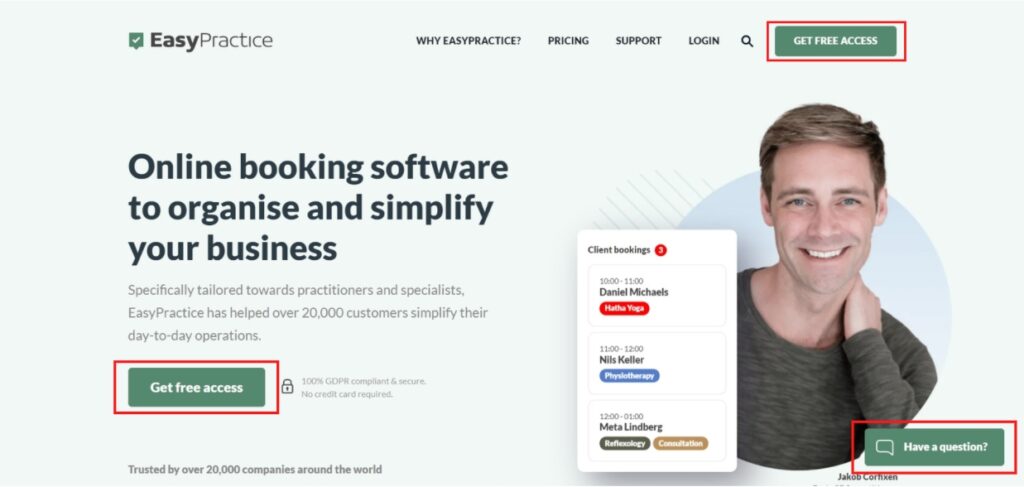Does your company rely on bookings to reach clients? Why is it important for companies to have a high-traffic booking website?
In today’s time, more people take advantage of the internet to book a service without having to leave their homes. Most have become accustomed to looking and searching online for clinics, restaurants, hotels, and so much more. Other people are present on social media channels and use them to get to know new products and services, some of the products people find are through their friends or celebrities who use them.
These new ways of looking for products and services represent a pool of opportunities to increase the traffic of your booking website. Therefore, it is essential to know the search engine algorithm in order to optimize your website. Being updated on this topic is the best way to show your products and services, reach new and potential clients, and, consequently, increase the number of bookings. In this guide, we will keep it simple and give actionable tips on how to make a booking website that can draw in a lot of traffic.
Booking page for increased visibility
There are several ways to create a booking page on your website. The two most common ways are either through WordPress (which requires some technical skills and experience on the platform) or to use a PMS software that already has all the functions. For the PMS software, you just need to find the one that is more suitable for your company, install it, and use it! As simple as that. If you have been looking at options but are not sure which one to choose, take a look at this blog post about “The best appointment scheduling and booking software”.
Overall, partnering with a company that offers an online booking system is the most recommended option because these systems are made specifically for companies in which booking is an essential part of their business. Once it is added to your company’s website, your employees should easily learn how to navigate it. The process of online booking should be intuitive, the software easy to use, and the clients should have no problem booking service of yours. Either way, you will have the software’s support team available to help you if there are any problems.
Optimize your company’s site for mobile booking and viewing
The convenience of using our mobile phones for almost everything has also changed the way we search and consume products and services online. Actually, 79% of smartphone users have made a purchase online using their mobile device in the last 6 months. It is imperative that your website is mobile adapted so consumers can easily look through your offers anywhere at any time. Otherwise, they will not even go to your booking page. But how do you even make a booking website mobile-friendly?
Appointment booking websites that are mobile-friendly are designed to work the exact same way across devices (desktop computers, laptops, tablets, or mobile phones). It means that the several features and functionalities of the website can still be used on the mobile version. Examples of this are:
- The frame of the website is adjusted to a smaller size and vertical orientation
- The picture size is adapted to its mobile version
- The buttons are still functional, no hidden sections of the page
- The user is able to scroll down with no delays.

Here’s an example of how the same page is portrayed on the desktop and mobile versions, respectively. They both have the same content and sections but the mobile version it’s adapted to be used on a phone’s touch screen with smaller prepositions. Delivering a smooth experience through your website on mobile devices will increase the number of bookings as there will be fewer technical obstacles to booking one of your services. Having a mobile-friendly website is also extremely important when it comes to improving your website’s SEO. Search engines such as Google will rank your website higher when prospective clients use your keywords and phrases in search. More about the SEO topic will be explained further down in this post.
Fill your company website with interesting content
Most likely, your audience wants to get to know more about what your company offers. They like to know details about your services, how the different package deals can be used, and how that can play a role in their lives. Also, delivering captivating content about your industry shows that you have expertise in the area. That makes you a more reliable and trustworthy company in your field, which attracts new clients, retains current ones, and, overall, increases the number of bookings.
There are several formats you can use to publish your content, such as:
- Blog posts
- Guides
- Infographics
- Videos, and
- Email campaigns.
The first two can be used to cover more extensive topics, whereas the last three can be used to capture the attention in a short time span and deliver more information quickly. Social media can be seen as a less informal method to deliver content, however, it could be the one your business needs to improve awareness and increase traffic to your booking service website. These platforms are widely used and can be a channel to spread your content and still keep it professional. Facebook can be used to share articles, promotions, or events that your company is creating. On Instagram, you can share images and short videos to give a sneak peek of what’s going on in your business.
Here’s where the booking software comes into play. Integrating your website and your social media account with the booking software will lead viewers who are interested in your content directly to the booking page.
Sign up for a free listing on Google My Business
A Google My Business account allows you to have your own profile that viewers can interact with on Google Search, Google Maps, and Google Plus. The account is for free. This snippet feature of your company on (for example) Google Search, lets your potential customers read essential information about your company and its services – easily and conveniently. The profile section shows what your business is about, your address, opening hours, phone number, and has a direct link to your booking page. This decreases the number of pages a person must go through to make a booking at your place.
Additionally, this snippet also gives the viewer information about reviews, what time your place is busiest, and the answers to frequently asked questions – all of which can be useful to make a quick decision about booking your services. There is also access to photos of your practice, interior space, and location, so your potential clients can get a sense of what happens inside your clinic.
When location is an important factor for your (potential) client, it makes a lot of sense to be able to use Google Maps. When your company has a Google My Business account, there is a higher chance of standing out if your practice is in the desired location of the person searching for it.
The Google My Business profile is highly interactive, intuitive, and increases the accessibility of your booking page.
Link your booking page everywhere
Are you making it easy for website visitors to see how to book a service with you?
Once the landing page for booking is set up, it’s crucial to link to it through several other pages of your website, social media account(s), and email marketing campaigns. It doesn’t only help search engines recognize this as your booking page but also makes the booking page extremely accessible for potential customers visiting your page.
The two essential placements for the booking page are in the top menu and in the footer of the website. You can also make use of call to action (CTA) buttons on several pages, such as blog posts, products, and services page, pricing section, about page, and so forth. Another option is to anchor the booking page link to a text throughout blog posts or pages.
Nevertheless, don’t overdo it. It doesn’t provide the best customer experience on your website if the client keeps being bombarded with flashy CTAs and pop-up windows. Place the booking CTA strategically where it is relevant.

Improve the SEO of your website
If you want people to discover your website and increase bookings, then search engine optimization (SEO) is a must.
SEO is the term that refers to boosting the websites in order to increase the chances of your website ranking higher on Google search. Leveraging your website’s SEO will make it appear on the first result page after someone uses key terms on a search engine. It is important that your page is SEO optimized so future customers can come across your page easily. Having so generates more clicks, overall traffic to your website, and increases the traffic on the booking page.
Here are some SEO tips that are essential to help search engines (and people) find your site:
Build a well designed website
Make sure that the pages of your website are readable, easy to scan, and that the viewer can quickly understand what the page is about. Also, consider building a site map so the links between your pages make sense and add value to the reader. Google provides this useful sitemap generator to help you with it.
A site map is a list of pages of a website within a domain. It’s used to plan the structure of a website, the hierarchy of the pages, and the structured listing intended for web crawlers such as search engines. So, in a few words, a site map is a blueprint of your website that shows how pages are linked together. It not only makes your website easier to navigate – but also enhances the optimization of the website for search engines.
Optimize your images
Keep the pictures on your website a manageable size to avoid slowing down the time it takes for the page to load. A nice rule of thumb is to resize the picture to have a maximum 1920 by 1080 pixel resolution.
Since most search engines cannot see pictures (yet), it is important to also add an ALT text to every image on your website. The ALT text is a descriptive text of what the picture is about. It helps search engines categorize your images and present them to searchers who use the keywords that match the ones used for your image. The ALT text shouldn’t be longer than 125 characters. When writing the ALT text, explain the picture as specifically as possible – as if you were explaining it to another person.

Having ALT texts also helps people who are visually impaired to know what is in the picture. People who are visually impaired often use a screen reader that will read the website for them – and if the pictures don’t have the ALT text, neither the screen reader nor the person will know what the picture is about. Therefore, the ALT text both makes your website more inclusive and optimized for search engines.
Be specific about what makes your company unique
Focus your website on what makes your business special and use keywords accordingly. Search engines want to point people to the websites that match the search term the most. So, if you are an expert in a particular field and want to explore the target audience within this field, then your website should reflect that.
Lean into what you bring to the table and avoid generalizing as that will make you blend with the competition and will make it harder to rank high on Google search. For example, if you are a chiropractor and also have excellent skills on chiropractic methods for athletes then use keywords related to it.
Reduce your website’s load time
Entering a page that takes time to scroll down and/or load text sections or pictures is not very inviting. Viewers are not willing to wait long for your site to load – in fact, 37% of visitors bounce when your site takes five seconds or more to load. Reduce the bounce rate (the rate at which people leave your website) by improving your website’s speed. There are several tools you can use to analyze and improve the page speed, such as Google My Test Site. It also provides you with more detailed information on this topic.
Write captivating meta descriptions
The meta description is the small descriptive text that appears under each search result page. It explains the purpose of that page and lets the viewer decide whether to click on it or not. The meta description should not be longer than 150 characters, and you must, therefore, use the characters wisely to let the searcher know what the page is about and the value it brings. It’s important to use simple language and include the keyword for the page in question. This could significantly improve your click-through rate (CTR) and consequently, increase the booking traffic.

Specify your URLs
As in the previous section, the URLs of your website should be readable and concise. This meant that the URL should provide information to the search engine about the content of the page and what the page is for. Make the URL readable and use the appropriate keyword. The Google search engine considers the keyword in the URL as much as the keywords on the page.
To create a URL that contains actual words instead of code, customize it in order to provide full comprehension of your content and what’s the topic in focus – and avoid using dynamically generated URLs. Also, the URL should only be as long as it is necessary to mention the title of the post, domain, and section of the website it belongs to. Avoid Long URLs made of random characters. As an example, let’s say you have a nutrition clinic. Your URLs should look something like this:
http://yourdomain.com/nutrition-clinic/appointment
Instead of:
http://yourdomain.com/index.php?=5754225=t44=?p=987
Use customer reviews to your advantage
Consumers rely more on previous customers’ experiences than they rely on your website’s credibility or your content expertise. Reviews can be a powerful tool to gain customer trust, encourage people to interact with your company, and increase booking traffic. The reviews could be a one-question-only survey such as evaluating the experience on a scale from 1 to 5 – or it could ask for a more descriptive opinion about the service. The review text gives a deeper insight into what exactly the clients liked about the service, which can be precisely what another person is looking for.
There are several ways to ask for feedback from clients. You could do so through a section of the website as a pop-up window, send the request by email a few days after the client’s visit, or you could ask right before the client leaves the establishment. Make sure to ask relevant questions (that in total, take a maximum of 5 minutes to answer). Address any negative or problematic reviews with a friendly and proactive approach. The way your company solves problems and improves the service has an impact on future clients’ perspectives too. Therefore, it is important to take customer service seriously and to be quick to correct any (perceived) mistakes. Reviews can increase your incoming traffic, the number of people entering your website, not only by referral traffic from the reviews website your clients might use to review your services but also organically.
Wrapping up
Creating a high-traffic booking website is not a piece of cake – but, hopefully, after reading this blog post you will have an idea of some techniques you can use to increase the number of bookings. The main strategy to apply is to improve the traffic of your own website so that searchers (who are looking for the services you offer) can find you with ease and book. The more points of connections there are with potential clients (such as social media platforms, content, and review websites), the higher the chances of connecting with leads and future customers.
This guide takes into consideration the latest updates on how Google rates websites, what aspects of the website improve its visibility and increase the number of bookings. However, these standards are constantly changing, and, therefore, the key is to keep yourself updated on what are website optimization best practices and improve the website accordingly.
If this post got you intrigued and you want to know more on how to get more clients, take a look at “The ultimate social media marketing guide for clinics” or “A Checklist for your Online Booking”.

 alt Online scheduling
alt Online scheduling alt Create special Vouchers for your services
alt Create special Vouchers for your services alt Prague by night
alt Prague by night